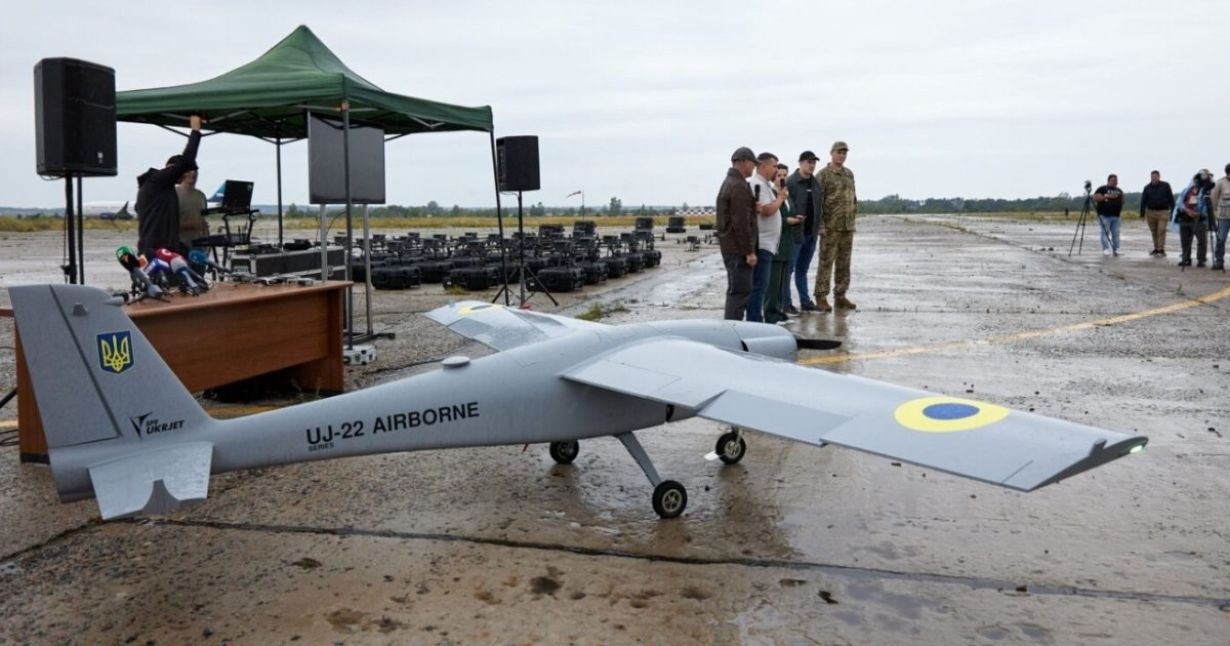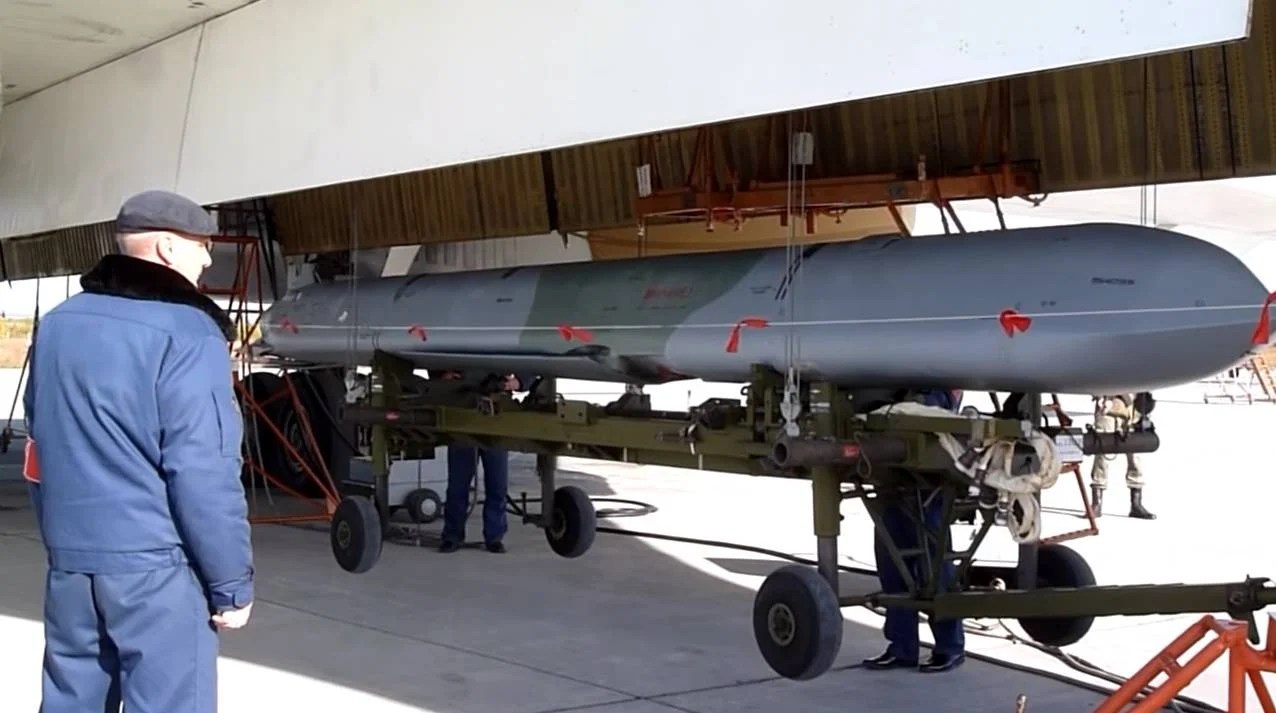Ukraine’s Bulky, Slow-Flying UAVs Outclass Russia’s Small, Fast, Stealthy Cruise Missiles; Here’s How & Why

Large and slow-flying Ukrainian drones like the UJ-22 Airborne and the A-22 Foxbat have had good success in penetrating Russia’s much-vaunted layered air defense. The drones have repeatedly struck heavily defended Russian air bases and energy storage and processing installations.
The Ukrjet UJ-22 Airborne is a single-engine drone that can either carry an internal warhead or several air-dropped bombs weighing up to 20 kg. It has a traditional light aircraft layout with straight high wings and a tractor propeller, simple straight wings, and fixed undercarriage.
The 3.7-meter-long drone, with a 4.2-meter-wide wing span, is one of the largest kamikaze drones known to be in service. It has a range of 800 km. The A22 Foxbat is a similar large drone.
Recent Damaging Ukrainian Drone Attacks
Since the start of the Ukrainian offensive in Kursk on August 6, Ukrainian drones have targeted air bases at Baltimor and Borisoglebsk in the Voronezh region and Savasleyka in the Nizhny Novgorod region.
On the night of August 22, Ukrainian drones attacked the Marinovo military airfield, where Su-24MR tactical aircraft are also based. Footage posted on social media accounts shows hits on the airfield territory and resulting fires. The attack also affected the Volgograd airport, disrupting flight operations temporarily.
AfriPrime App link: FREE to download...
https://www.amazon.com/Africircle-AfriPrime/dp/B0D2M3F2JT
Russian firefighters struggled for five days to put out a fire at an oil depot in the town of Proletarsk caused by a Ukrainian drone attack on August 18.
Also, on the night of August 22, Ukrainian drones targeted an oil refinery in the Volgograd region, sparking a fire at a military facility. Andrei Bocharov, governor of the Volgograd region, said that a “defense ministry facility” was on fire after being attacked by drones in the area of Marinovka.
These strikes demonstrate Ukraine’s increasing capability to conduct long-range drone operations, impacting critical infrastructure and military assets in Russia.

Russian Cruise Missiles – Less Impressive
In contrast, the success of smaller, stealthier, and faster-flying Russian cruise missiles in penetrating Ukrainian air space has been surprisingly limited, almost disappointing.
The Russian Kalibr 3M-14 Cruise Missile, for example, is much smaller than a UJ-22 drone. It has a much stealthier design and flies almost seven times the speed of the drone.
Yet, statistics released by the General Staff of Ukraine on the effectiveness of its air defense indicate that the penetration rate of the Kaiber is just 50%. The penetration rate of the even stealthier Russian Kh-101 missile is worse, at around 30%. It’s likely that statistics released by the Ukrainian authorities are doctored, but they do reveal a trend.
Drones, Cruise Missiles As Targets
Engaging a small, low-observable cruise missile flying a terrain-hugging profile at 850 kph should be at least 10 times more difficult than engaging a much larger, non-stealthy drone flying at a similar altitude at 120 kph!
Russian air defenses are as good as Ukrainian air defenses, possibly better. With the Kh-101’s penetration rate of just 30%, one would expect the penetration rate of a UJ-22 to be near zero.
However, that is not the case. Considering the frequency of successful Ukrainian drone strikes, the penetration rate could be as much as 5% – 10%
Reasons Why Ukrainian Drones Do Better
There are two good reasons why Ukrainian drones are able to penetrate Russian airspace.
AfriPrime App link: FREE to download...
https://www.amazon.com/Africircle-AfriPrime/dp/B0D2M3F2JT
-
Remote Piloting
-
Realtime ISR Support from US/NATO ISR assets
Remote Piloting
Drones like the UJ-22 and A22 can operate in both remotely piloted and autonomous modes.
When used for strike missions, the drones are remotely piloted, facilitating better radar avoidance and more precise targeting.
Radar detection is most effectively avoided, not by stealth design, but by flying lower than the radar horizon. To follow a more effective nap-of-the-earth (NOE) profile that minimizes chances of radar detection, the Ukrainian drones visually avoid terrain.
Cruise missiles such as the 3M-14 Kalibre and the Kh-101 can only fly in autonomous mode. To avoid crashing into terrain, they rely on a programmed flight profile that adjusts cruising altitude to the expected terrain below.

Autonomous terrain avoidance needs to accommodate navigational errors. As a result, cruise missiles generally fly much higher than they need to avoid terrain that they could crash into if they drift off track because of strong winds or navigational errors. As a result, cruise missiles are more prone to radar detection than larger, unstealthy drones.
Remote piloting also allows the pilot to positively identify the target and choose the best mode (kamikaze or bomb drop) of attack, and the optimum terminal path and trajectory. The results can be spectacular as compared to cruise missile attacks.
Realtime ISR Support from US/NATO ISR assets
Another important reason for the better-than-expected penetration of Ukrainian drones is the real-time ISR support provided by airborne US/NATO ISR assets.
US/NATO aircraft, such as the manned RC-135 and the unmanned RQ-4 Global Hawk and MQ-9 Reaper, monitor the operation of Russian radars 24×7 from outside Russia’s borders. They can detect gaps in radar coverage, including gaps arising from scheduled maintenance and temporary breakdowns.
Also, Russia is a vast country, and its radar/air defense coverage is unlikely to be 100%. The large drones used for attack have a long range and can be routed to leverage the gaps.
The situational awareness provided by the US/NATO ISR assets not only facilitates safe routing when planning the mission but also allows drone pilots to alter their tracks based on real-time data.
Russian Countermeasures
Russia is developing measures to plug the gaps in its air defense coverage. One recently announced measure is the introduction of a counter-drone variant of the Yak-52M trainer aircraft.
The counter-drone variant, Yak-52B2, will be fitted with radar and new instrumentation, including a multifunctional display in the rear cockpit. In addition to modernized navigation and flight equipment, it will feature an electronic warfare system for suppressing communication channels.
Yak-52B2 aircraft will likely be used to patrol Russian airspace with inadequate air defense coverage. They will detect any low-flying drone using their airborne radar and incapacitate them.
AfriPrime App link: FREE to download...
- Questions and Answers
- Opinion
- Story/Motivational/Inspiring
- Technology
- Art
- Causes
- Crafts
- Dance
- Drinks
- Film/Movie
- Fitness
- Food
- Παιχνίδια
- Gardening
- Health
- Κεντρική Σελίδα
- Literature
- Music
- Networking
- άλλο
- Party
- Religion
- Shopping
- Sports
- Theater
- Wellness
- News
- Culture
- War machines and policy

